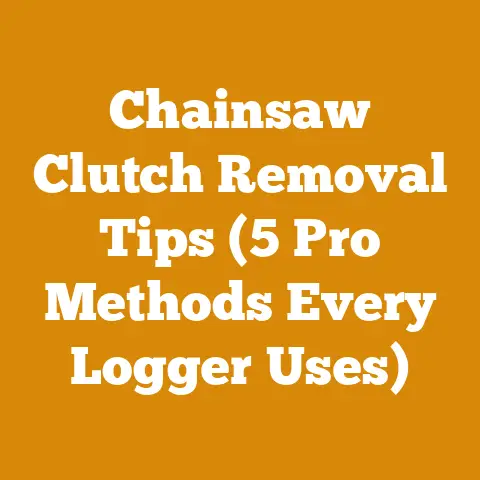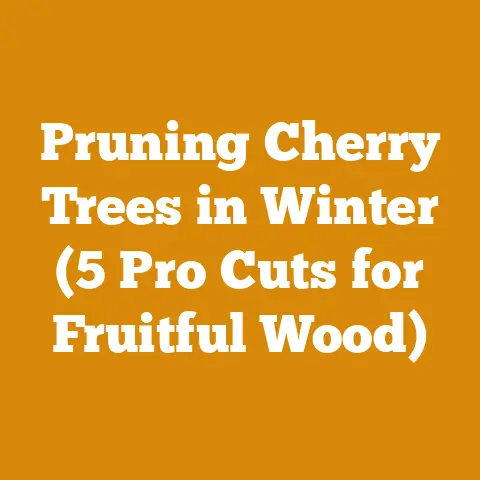Portable Tree Shredder: Is It Worth It for Wood Processing? (Expert Insights)
The crisp autumn air bites at my cheeks, carrying the scent of damp earth and decaying leaves. The woods are alive with the vibrant hues of fall – crimson maples, golden birches, and rusty oaks. I find myself standing at the edge of a sprawling woodlot, a familiar landscape that has been both my sanctuary and my workshop for over two decades. For years, I’ve wrestled with fallen trees, unruly branches, and the endless cycle of turning wood into warmth. The question of efficient wood processing has always been top of mind. Today, we’re diving deep into a topic that has been buzzing in the wood processing community: portable tree shredders. Are they just a fancy gadget, or a game-changer for small-scale wood processing and firewood preparation? Let’s find out.
Portable Tree Shredder: Is It Worth It for Wood Processing? (Expert Insights)
The global wood processing and firewood industry is a significant economic driver. According to recent statistics, the global firewood market alone is projected to reach \$15.8 billion by 2027, demonstrating the enduring demand for this traditional fuel source. Simultaneously, the timber industry is undergoing technological advancements, with a growing emphasis on sustainable forestry practices and efficient wood utilization. Portable tree shredders, also known as wood chippers, represent one such advancement, offering a potential solution for managing wood waste and producing valuable wood chips for various applications. But do they really live up to the hype?
Understanding the Landscape: Wood Processing Challenges and Opportunities
Before we delve into the specifics of portable tree shredders, let’s take a step back and appreciate the challenges and opportunities that exist in wood processing.
- Wood Waste: A significant portion of harvested timber ends up as waste – branches, treetops, and unusable logs. Traditionally, this waste is often burned or left to decompose, representing a loss of valuable resources.
- Labor Intensity: Manual wood processing, such as de-limbing, bucking (cutting into shorter lengths), and splitting, is physically demanding and time-consuming.
- Environmental Concerns: Open burning of wood waste contributes to air pollution. Sustainable wood processing practices are increasingly important.
- Value-Added Products: Wood chips produced by shredders can be used for various purposes, including mulch, compost, animal bedding, and even biofuel production, creating opportunities for generating additional income.
These challenges and opportunities highlight the need for efficient and sustainable wood processing solutions, and portable tree shredders offer a promising avenue to explore.
What Exactly is a Portable Tree Shredder?
A portable tree shredder, in its simplest form, is a machine designed to reduce woody material – branches, small trees, and other wood waste – into smaller pieces, typically wood chips. These machines come in various sizes and power levels, ranging from small electric models suitable for homeowners to larger, gas-powered or PTO-driven (power take-off) units designed for professional use.
Key Components of a Portable Tree Shredder
Understanding the key components of a portable tree shredder will help you make an informed decision when considering a purchase.
- Hopper: The hopper is the opening where you feed the wood material into the shredder. The size and shape of the hopper can vary depending on the model. A wider hopper can accommodate larger branches, while a narrower hopper may require more pre-processing.
- Cutting Mechanism: This is the heart of the shredder. The cutting mechanism typically consists of blades, knives, or hammers that rotate at high speed to chip or shred the wood. The type of cutting mechanism affects the size and consistency of the wood chips produced.
- Engine/Motor: The engine or motor provides the power to drive the cutting mechanism. Smaller shredders typically use electric motors, while larger models use gasoline or diesel engines. PTO-driven models are powered by the tractor’s power take-off shaft.
- Discharge Chute: The discharge chute directs the wood chips away from the shredder. Some models have adjustable discharge chutes that allow you to control the direction of the chips.
- Wheels/Frame: The wheels and frame provide mobility and stability. The portability of the shredder is a key factor to consider, especially if you need to move it around your property or transport it to different job sites.
Types of Portable Tree Shredders
Portable tree shredders can be broadly classified into several types, based on their power source, cutting mechanism, and capacity.
- Electric Shredders: These are typically smaller and less powerful than gas-powered models. They are suitable for light-duty tasks, such as shredding small branches and leaves. They are quieter and produce no emissions, making them ideal for residential use.
- Gas-Powered Shredders: These are more powerful and can handle larger branches and more demanding tasks. They are suitable for homeowners with larger properties and professionals who need a portable shredder for occasional use.
- PTO-Driven Shredders: These are the most powerful and are designed for professional use. They are powered by the tractor’s power take-off shaft and can handle large volumes of wood waste. They are typically more expensive than electric or gas-powered models.
- Chipper Shredders: These combine a chipper (for branches) and a shredder (for leaves and smaller debris) into one machine. They are versatile and can handle a wide range of wood waste.
- Drum Chippers: These use a rotating drum with knives to chip the wood. They are typically used for larger branches and logs.
- Disc Chippers: These use a rotating disc with knives to chip the wood. They are typically used for smaller branches and logs.
The Million-Dollar Question: Are They Worth It?
Now, let’s get to the heart of the matter: is a portable tree shredder worth the investment for wood processing? The answer, as with most things, is it depends. It depends on your specific needs, the scale of your wood processing operations, and your budget.
Benefits of Using a Portable Tree Shredder
Here’s a breakdown of the benefits that portable tree shredders can offer:
- Reduced Wood Waste: Shredders transform wood waste into valuable wood chips, reducing the amount of material that ends up in landfills or is burned.
- Increased Efficiency: Shredders can significantly speed up the process of wood processing, especially when dealing with large volumes of branches and small trees.
- Versatile Wood Chips: Wood chips can be used for a variety of purposes, including mulch, compost, animal bedding, and even biofuel production.
- Reduced Fire Hazard: By removing and processing wood waste, you can reduce the risk of wildfires on your property.
- Improved Aesthetics: Shredding wood waste can improve the overall appearance of your property, creating a cleaner and more organized landscape.
- Reduced Labor: Shredders can reduce the amount of manual labor required for wood processing, freeing up your time for other tasks.
Drawbacks of Using a Portable Tree Shredder
While portable tree shredders offer numerous benefits, there are also some drawbacks to consider:
- Cost: Shredders can be a significant investment, ranging from a few hundred dollars for small electric models to several thousand dollars for larger gas-powered or PTO-driven units.
- Maintenance: Shredders require regular maintenance, including blade sharpening, oil changes, and filter replacements.
- Safety: Shredders can be dangerous if not used properly. It’s essential to follow all safety instructions and wear appropriate personal protective equipment (PPE).
- Noise: Gas-powered shredders can be quite noisy, which can be a concern in residential areas.
- Size Limitations: Most portable shredders have limitations on the size of branches they can handle. You may need to pre-process larger branches before feeding them into the shredder.
- Chip Quality: The quality of the wood chips produced by a shredder can vary depending on the model and the type of wood being processed. Some shredders may produce chips that are too coarse or uneven for certain applications.
Who Should Consider a Portable Tree Shredder?
Based on the benefits and drawbacks, here’s a guide to who might benefit most from owning a portable tree shredder:
- Homeowners with Large Properties: If you have a large property with many trees, a shredder can be a valuable tool for managing wood waste and producing mulch for your garden.
- Hobby Farmers: If you raise livestock, wood chips can be used for animal bedding. They can also be used as a soil amendment in your garden.
- Landscapers: Shredders can be used to process branches and other wood waste generated during landscaping projects.
- Small-Scale Firewood Producers: While not a direct firewood production tool, a shredder can help manage the “waste” wood from the process, turning unusable limbs into mulch or other sellable products.
- Professional Arborists: Arborists can use shredders to process branches and other wood waste generated during tree trimming and removal projects.
- Community Gardens: Shredders can be used to process garden waste and produce compost for the garden.
Who Might Not Need a Portable Tree Shredder?
On the other hand, a portable tree shredder might not be necessary for everyone.
- Homeowners with Small Properties: If you have a small property with few trees, you may not generate enough wood waste to justify the cost of a shredder.
- Those Who Prefer to Burn Wood Waste: If you have a wood stove or fireplace and prefer to burn wood waste, a shredder may not be necessary. However, be mindful of local regulations regarding open burning.
- Those Who Can Easily Dispose of Wood Waste: If you have access to a local landfill or composting facility that accepts wood waste, you may not need a shredder.
- Those with Limited Storage Space: Shredders can take up a significant amount of storage space, which can be a concern for those with limited space.
Choosing the Right Portable Tree Shredder: A Step-by-Step Guide
If you’ve decided that a portable tree shredder is right for you, the next step is to choose the right model. Here’s a step-by-step guide to help you make an informed decision:
Step 1: Assess Your Needs
- What type of wood waste will you be processing? (Branches, leaves, small trees, etc.)
- What is the maximum diameter of the branches you will be processing?
- How much wood waste do you generate per year?
- What will you use the wood chips for? (Mulch, compost, animal bedding, etc.)
- What is your budget?
- Do you need a portable shredder, or will a stationary model suffice?
- Do you have access to a tractor with a PTO?
- What is your noise tolerance?
Step 2: Research Different Models
- Read online reviews and compare different models.
- Visit local dealers and talk to experts.
- Consider the features and specifications of each model. (Engine size, cutting mechanism, hopper size, discharge chute, etc.)
- Check the warranty and service options.
Step 3: Consider the Power Source
- Electric Shredders: Suitable for light-duty tasks and residential use.
- Gas-Powered Shredders: Suitable for heavier-duty tasks and larger properties.
- PTO-Driven Shredders: Suitable for professional use and large volumes of wood waste.
Step 4: Evaluate the Cutting Mechanism
- Blades/Knives: Produce finer chips, suitable for mulch and compost.
- Hammers: Produce coarser chips, suitable for animal bedding.
- Chipper Shredders: Versatile and can handle a wide range of wood waste.
Step 5: Check the Hopper Size
- A larger hopper can accommodate larger branches, reducing the need for pre-processing.
Step 6: Consider the Discharge Chute
- An adjustable discharge chute allows you to control the direction of the chips.
Step 7: Evaluate Portability
- Consider the weight and size of the shredder.
- Check the wheel size and type.
- Make sure the shredder is easy to move around your property.
Step 8: Check the Safety Features
- Look for safety features such as safety guards, emergency shut-off switches, and overload protection.
Step 9: Read the Owner’s Manual
- Before using the shredder, read the owner’s manual carefully and follow all safety instructions.
Step 10: Consider Renting Before Buying
- If you’re not sure whether you need a shredder, consider renting one for a day or two to see if it meets your needs.
Case Study: My Experience with a Gas-Powered Chipper Shredder
Let me share a personal anecdote. A few years ago, I invested in a gas-powered chipper shredder. I had been accumulating a mountain of branches and small trees from clearing brush and managing my woodlot. Hauling it all away was back-breaking work, and burning it felt wasteful.
The chipper shredder proved to be a game-changer. It allowed me to efficiently process the wood waste into mulch for my garden and pathways. The mulch not only suppressed weeds but also helped retain moisture in the soil. I even started selling some of the excess mulch to neighbors, generating a small income stream.
However, it wasn’t all smooth sailing. I quickly learned the importance of wearing proper PPE, including safety glasses, ear protection, and gloves. I also had a close call when a small branch kicked back out of the hopper. Thankfully, I was wearing safety glasses, and the branch only grazed my cheek. That experience reinforced the importance of following all safety instructions and being mindful of the potential hazards.
The maintenance was also more involved than I anticipated. Sharpening the blades was a regular task, and I had to be diligent about changing the oil and cleaning the air filter. But overall, the benefits of owning a chipper shredder far outweighed the drawbacks. It saved me time and effort, reduced wood waste, and provided me with a valuable resource for my garden.
Safety First: Operating a Portable Tree Shredder Safely
Operating a portable tree shredder can be dangerous if not done properly. Here are some essential safety tips to keep in mind:
- Read the Owner’s Manual: Before operating the shredder, read the owner’s manual carefully and follow all safety instructions.
- Wear Proper PPE: Always wear safety glasses, ear protection, gloves, and sturdy footwear.
- Clear the Work Area: Before starting the shredder, clear the work area of any obstacles, such as rocks, branches, and debris.
- Keep Children and Pets Away: Keep children and pets away from the shredder at all times.
- Never Reach into the Hopper: Never reach into the hopper while the shredder is running. Use a stick or push tool to feed the wood material into the shredder.
- Don’t Overload the Shredder: Don’t overload the shredder with too much material at once. Feed the wood material in gradually.
- Be Aware of Kickback: Be aware of the potential for kickback, which can occur when a branch or piece of wood is ejected from the hopper.
- Turn Off the Shredder Before Servicing: Always turn off the shredder and disconnect the spark plug wire before performing any maintenance or repairs.
- Inspect the Shredder Regularly: Inspect the shredder regularly for any signs of damage or wear. Replace any worn or damaged parts immediately.
- Stay Sober: Never operate a shredder under the influence of alcohol or drugs.
Common Pitfalls to Avoid
Here are some common pitfalls to avoid when using a portable tree shredder:
- Ignoring Safety Instructions: This is the most common and potentially most dangerous mistake. Always read and follow the owner’s manual carefully.
- Feeding the Shredder Incorrectly: Feeding the shredder too quickly or with the wrong type of material can cause jams and damage to the machine.
- Neglecting Maintenance: Neglecting regular maintenance can shorten the lifespan of the shredder and increase the risk of breakdowns.
- Using the Shredder in Wet Conditions: Using the shredder in wet conditions can damage the engine and electrical components.
- Storing the Shredder Improperly: Storing the shredder improperly can lead to rust and corrosion.
Maximizing the Value of Your Wood Chips
Once you’ve shredded your wood waste, it’s time to put those wood chips to good use. Here are some ideas:
- Mulch: Wood chips make excellent mulch for gardens and flower beds. They help suppress weeds, retain moisture, and regulate soil temperature.
- Compost: Wood chips can be added to your compost pile to improve aeration and drainage.
- Animal Bedding: Wood chips can be used as bedding for livestock, such as chickens, horses, and cows.
- Pathways: Wood chips can be used to create pathways in your garden or around your property.
- Playground Surfacing: Wood chips can be used as a safe and natural surfacing material for playgrounds.
- Biofuel: In some areas, wood chips can be used as a fuel source for biomass power plants.
- Erosion Control: Wood chips can be used to control erosion on slopes and hillsides.
Wood Chip Composition and Its Impact on Usage
The type of wood you shred will influence the composition of the chips and, consequently, their suitability for various applications.
- Hardwood Chips: Decompose slower, making them ideal for long-lasting mulch or pathways. However, they can temporarily tie up nitrogen in the soil if used as a direct soil amendment.
- Softwood Chips: Decompose faster, releasing nutrients into the soil. They are a good choice for composting or using as a soil amendment, but they may not last as long as hardwood chips as mulch.
- Leafy Material: Shredding leaves along with branches can create a richer compost, but too much leafy material can make the chips decompose too quickly for certain applications.
Understanding the composition of your wood chips will help you choose the best uses for them.
Cost Analysis and Budgeting
Investing in a portable tree shredder requires careful consideration of the costs involved. Here’s a breakdown of the key cost factors:
- Purchase Price: The initial cost of the shredder can range from a few hundred dollars to several thousand dollars, depending on the size, power, and features.
- Maintenance Costs: Regular maintenance, such as blade sharpening, oil changes, and filter replacements, can add up over time.
- Fuel Costs: Gas-powered shredders require gasoline, which can be a significant expense, especially if you use the shredder frequently.
- Repair Costs: Repairs can be costly, especially if the shredder is damaged due to improper use or neglect.
- Storage Costs: If you don’t have a garage or shed, you may need to rent storage space for the shredder.
To create a budget, estimate your annual wood processing needs, research the costs of different shredder models, and factor in the ongoing maintenance and operating expenses. Don’t forget to consider the potential savings from reduced waste disposal costs and the value of the wood chips you produce.
ROI (Return on Investment) Considerations
While the initial investment in a shredder might seem substantial, consider the potential return on investment. If you currently pay for waste removal services for yard waste, a shredder can eliminate those costs. If you purchase mulch regularly, producing your own mulch can save you money. And, as I mentioned earlier, you might even be able to sell excess wood chips to generate income.
To calculate the ROI, compare the total cost of owning and operating the shredder over its lifespan to the total savings and income generated from its use.
The Future of Portable Tree Shredders
The future of portable tree shredders looks promising, with ongoing advancements in technology and design. Here are some trends to watch for:
- Electric Shredders: Electric shredders are becoming more powerful and efficient, making them a more attractive option for homeowners and professionals.
- Battery-Powered Shredders: Battery-powered shredders offer the convenience of cordless operation and reduced emissions.
- Smart Shredders: Some shredders are now equipped with smart features, such as automatic jam clearing and remote monitoring.
- More Compact Designs: Manufacturers are developing more compact and lightweight shredders that are easier to transport and store.
- Improved Safety Features: Safety features are constantly being improved to reduce the risk of accidents.
As technology advances, portable tree shredders will likely become more affordable, efficient, and user-friendly, making them an even more valuable tool for wood processing.
Next Steps and Additional Resources
If you’re ready to take the plunge and invest in a portable tree shredder, here are some next steps:
- Revisit Your Needs Assessment: Review your wood processing needs and budget to narrow down your options.
- Research Local Dealers: Visit local dealers and talk to experts to get personalized recommendations.
- Read Online Reviews: Read online reviews and compare different models to get a sense of their performance and reliability.
- Consider Renting: If possible, rent a shredder for a day or two to try it out before you buy it.
- Check Warranty and Service Options: Make sure the shredder comes with a good warranty and that service is readily available in your area.
Here are some additional resources that you may find helpful:
- Local Arborist Associations: These associations can provide information on tree care and wood processing.
- University Extension Services: Your local university extension service may offer workshops and resources on wood processing and composting.
- Online Forums: There are many online forums dedicated to wood processing and firewood preparation where you can ask questions and share tips.
- Suppliers of Logging Tools: Forestry Suppliers, Baileys, and Northern Tool + Equipment are reputable suppliers of logging tools and equipment.
- Drying Equipment Rental Services: Sunbelt Rentals and United Rentals may offer drying equipment rental services for large-scale firewood production.
Conclusion: A Worthwhile Investment with Careful Consideration
So, circling back to the original question: is a portable tree shredder worth it for wood processing? My answer is a resounding “it depends,” but with a strong lean towards “yes” for the right person. If you’re a homeowner with a large property, a hobby farmer, a landscaper, or a small-scale firewood producer, a portable tree shredder can be a valuable investment. It can help you reduce wood waste, increase efficiency, and generate valuable resources for your garden, farm, or business.
However, it’s essential to do your research, assess your needs, and choose the right model for your specific situation. Always prioritize safety and follow all operating instructions carefully. With proper planning and execution, a portable tree shredder can be a game-changer for your wood processing operations. Now, if you’ll excuse me, I’ve got a mountain of branches waiting to be transformed into mulch. Happy shredding!






